mirror SKODA OCTAVIA 2012 2.G / (1Z) User Guide
[x] Cancel search | Manufacturer: SKODA, Model Year: 2012, Model line: OCTAVIA, Model: SKODA OCTAVIA 2012 2.G / (1Z)Pages: 222, PDF Size: 13.52 MB
Page 55 of 222
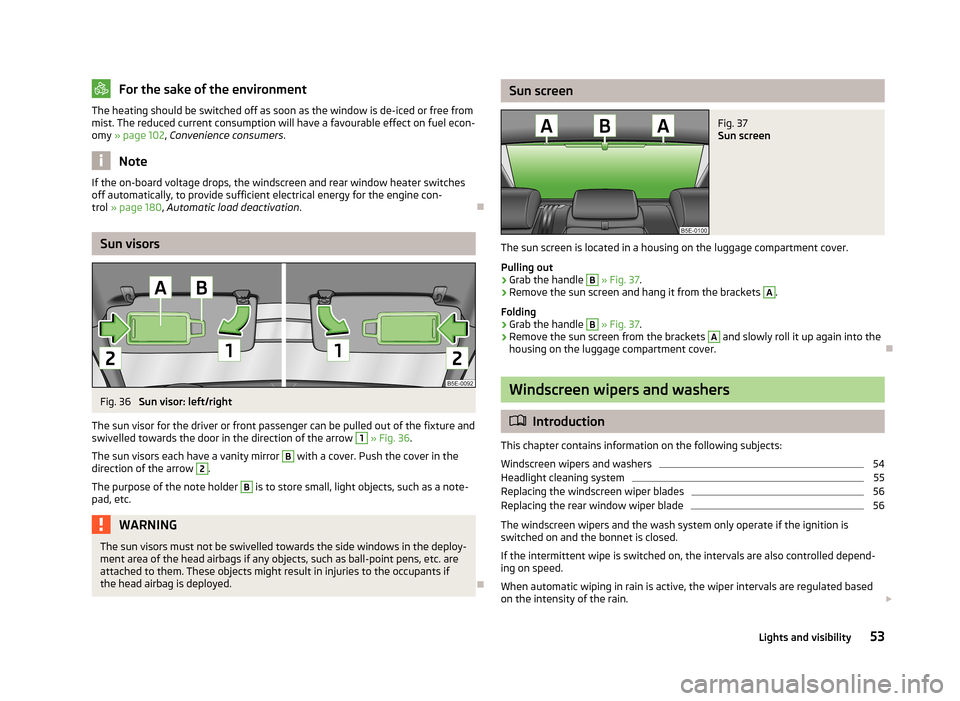
For the sake of the environmentThe heating should be switched off as soon as the window is de-iced or free from
mist. The reduced current consumption will have a favourable effect on fuel econ-
omy » page 102 , Convenience consumers .
Note
If the on-board voltage drops, the windscreen and rear window heater switches
off automatically, to provide sufficient electrical energy for the engine con-
trol » page 180 , Automatic load deactivation .ï
Sun visors
Fig. 36
Sun visor: left/right
The sun visor for the driver or front passenger can be pulled out of the fixture and
swivelled towards the door in the direction of the arrow
1
» Fig. 36 .
The sun visors each have a vanity mirror
B
with a cover. Push the cover in the
direction of the arrow
2
.
The purpose of the note holder
B
is to store small, light objects, such as a note-
pad, etc.
WARNINGThe sun visors must not be swivelled towards the side windows in the deploy-
ment area of the head airbags if any objects, such as ball-point pens, etc. are attached to them. These objects might result in injuries to the occupants if
the head airbag is deployed.
ï
Sun screenFig. 37
Sun screen
The sun screen is located in a housing on the luggage compartment cover.
Pulling out
âº
Grab the handle
B
» Fig. 37 .
âº
Remove the sun screen and hang it from the brackets
A
.
Folding
âº
Grab the handle
B
» Fig. 37 .
âº
Remove the sun screen from the brackets
A
and slowly roll it up again into the
housing on the luggage compartment cover.
ï
Windscreen wipers and washers
ï¤ Introduction
This chapter contains information on the following subjects:
Windscreen wipers and washers
54
Headlight cleaning system
55
Replacing the windscreen wiper blades
56
Replacing the rear window wiper blade
56
The windscreen wipers and the wash system only operate if the ignition is
switched on and the bonnet is closed.
If the intermittent wipe is switched on, the intervals are also controlled depend-
ing on speed.
When automatic wiping in rain is active, the wiper intervals are regulated based
on the intensity of the rain. ï£
53Lights and visibility
Page 58 of 222

Replacing the windscreen wiper bladesFig. 39
Windscreen wiper blade
First read and observe the introductory information and safety warn-ings on page 53.
Before replacing the windscreen wiper blade, put the windscreen wiper arms into
the service position.
Service position for changing wiper blades
âº
Closing the bonnet.
âº
Switch the ignition off and on again.
âº
Within 10 seconds, press the lever in position
4
and keep it held for around 2
seconds » Fig. 38 on page 54.
The windscreen wiper arms move into the service position.
Removing the wiper blade
âº
Raise the windscreen wiper arm away from the windscreen » Fig. 39.
âº
Tilt the wiper blade as far as it can go in the direction of the windscreen wiper
arm - arrow
A
.
âº
Hold the upper part of the windscreen wiper arm and unlock the securing mech-
anism
1
.
âº
Remove the wiper blade in the direction of the arrow
B
.
Attaching the wiper blade
âº
Push the windscreen wiper blade until the stop and it locks in place.
âº
Check that the wiper blade is correctly attached.
âº
Fold the wiper arms back to the windscreen.
âº
Turn on the ignition and press the lever into position
4
» Fig. 38 on page 54.
The windscreen wiper arms move into the home position.
ï
ï¤Replacing the rear window wiper bladeFig. 40
Rear window wiper blade
First read and observe the introductory information and safety warn- ings on page 53.
Removing the wiper blade
âº
Raise the windscreen wiper arm away from the windscreen » Fig. 40.
âº
Tilt the wiper blade as far as it can go in the direction of the windscreen wiper
arm - arrow
A
.
âº
Hold the upper part of the windscreen wiper arm and unlock the securing mech-
anism
1
.
âº
Remove the wiper blade in the direction of the arrow
B
.
Attaching the wiper blade
âº
Push the windscreen wiper blade until the stop and it locks in place.
âº
Check that the wiper blade is correctly attached.
âº
Fold the wiper arm back to the windscreen.
ï
Rear mirror
ï¤ Introduction
This chapter contains information on the following subjects:
Interior mirror
57
Exterior mirror
58
ï£
ï¤56Using the system
Page 59 of 222
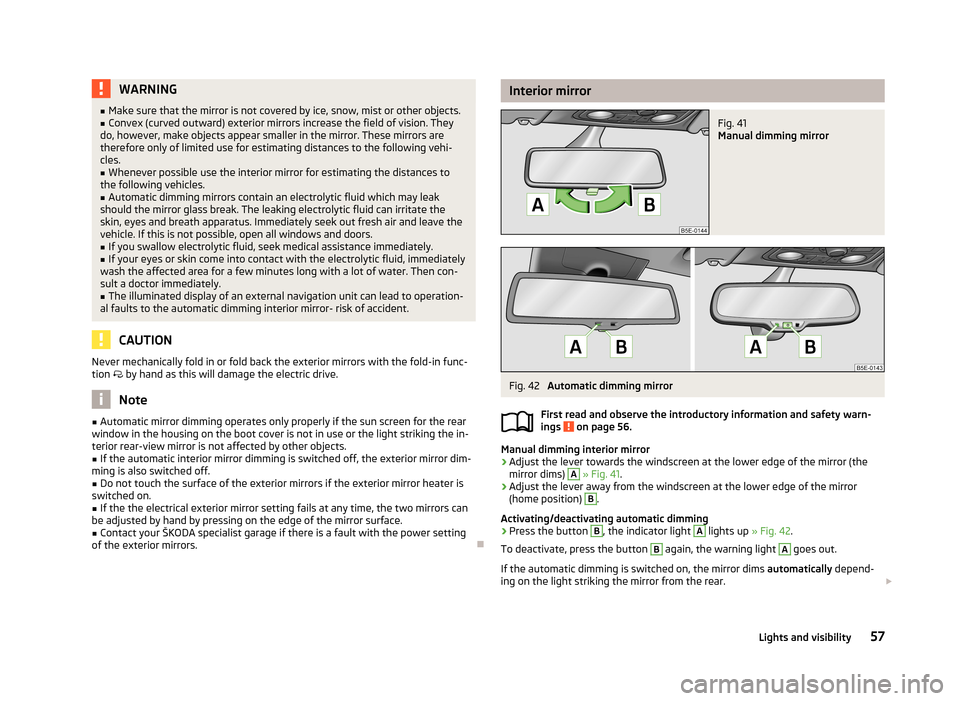
WARNINGâ Make sure that the mirror is not covered by ice, snow, mist or other objects.â Convex (curved outward) exterior mirrors increase the field of vision. They
do, however, make objects appear smaller in the mirror. These mirrors are
therefore only of limited use for estimating distances to the following vehi-
cles.â
Whenever possible use the interior mirror for estimating the distances to
the following vehicles.
â
Automatic dimming mirrors contain an electrolytic fluid which may leak
should the mirror glass break. The leaking electrolytic fluid can irritate the skin, eyes and breath apparatus. Immediately seek out fresh air and leave thevehicle. If this is not possible, open all windows and doors.
â
If you swallow electrolytic fluid, seek medical assistance immediately.
â
If your eyes or skin come into contact with the electrolytic fluid, immediately
wash the affected area for a few minutes long with a lot of water. Then con-
sult a doctor immediately.
â
The illuminated display of an external navigation unit can lead to operation-
al faults to the automatic dimming interior mirror- risk of accident.
CAUTION
Never mechanically fold in or fold back the exterior mirrors with the fold-in func-
tion ï« by hand as this will damage the electric drive.
Note
â
Automatic mirror dimming operates only properly if the sun screen for the rear
window in the housing on the boot cover is not in use or the light striking the in- terior rear-view mirror is not affected by other objects.â
If the automatic interior mirror dimming is switched off, the exterior mirror dim-
ming is also switched off.
â
Do not touch the surface of the exterior mirrors if the exterior mirror heater is
switched on.
â
If the the electrical exterior mirror setting fails at any time, the two mirrors can
be adjusted by hand by pressing on the edge of the mirror surface.
â
Contact your Å KODA specialist garage if there is a fault with the power setting
of the exterior mirrors.
ï
Interior mirrorFig. 41
Manual dimming mirror
Fig. 42
Automatic dimming mirror
First read and observe the introductory information and safety warn-
ings
on page 56.
Manual dimming interior mirror
âº
Adjust the lever towards the windscreen at the lower edge of the mirror (the mirror dims)
A
» Fig. 41 .
âº
Adjust the lever away from the windscreen at the lower edge of the mirror
(home position)
B
.
Activating/deactivating automatic dimming
âº
Press the button
B
, the indicator light
A
lights up » Fig. 42.
To deactivate, press the button
B
again, the warning light
A
goes out.
If the automatic dimming is switched on, the mirror dims automatically depend-
ing on the light striking the mirror from the rear. ï£
ï¤57Lights and visibility
Page 60 of 222

When the interior lights are switched on or the reverse gear is engaged, the mir-
ror always moves back into the basic position (not dimmed).
Do not attach external navigation devices on to the windscreen or in the vicinity
of the automatic dimming interior mirror » page 57,
in section Introduction .
ï
Exterior mirror
Fig. 43
Inner part of door: Rotary knob
First read and observe the introductory information and safety warn-
ings on page 56.
Mirror heater
âº
Set the rotary knob into the position ï
» Fig. 43 .
The mirror heater only operates when the engine is running and up to an outside temperature of +35 â.
Adjusting both mirrors in sync
âº
Set the rotary dial into position ï
or, on right-hand drive vehicles, into position
ï » Fig. 43 . The movement of the mirror surface is identical to the movement of
the rotary knob.
The synchronous setting of both mirrors can be activated/deactivated in the Info-
tainment » operating instructions for Infotainment , chapter Setting vehicle sys-
tems (CAR button) .
Adjusting the front passenger's mirror
âº
Set the rotary dial into position ï
or, on right-hand drive vehicles, into position
ï
» Fig. 43 . The movement of the mirror surface is identical to the movement of
the rotary knob.
Switching off operating control
âº
Set the rotary knob into the position ï°
» Fig. 43 .
ï¤Folding-in both of the exterior mirrors with the rotary knobâºSet the rotary knob into the position ï« Â» Fig. 43 .
It is only possible to fold in both exterior mirrors when the ignition is switched on and at a speed of up to 50 km/h.
The mirrors are folded back into the driving position after the rotary knob is
turned from the position ï« to a different one.
Folding-in both of the exterior mirrors using the remote control keyâº
Hold down the lock button ï§ on the remote control key, or when using the
KESSY system, keep your finger on the sensor
1
» Fig. 15 on page 33.
Folding in requires that all electrical power windows are working » page 41, Op-
erational faults in the automatic power windows .
The exterior mirror is folded back into the driving position when the ignition is
switched on.
Folding in of both mirrors can be activated/deactivated in the Infotainment » op-
erating instructions for Infotainment , chapter Setting vehicle systems (CAR but-
ton) .
Automatic dimming mirror
The exterior mirrors are dimmed together with the automatic dimming interior
mirror » page 57 .
Tilting surface of front passenger mirror
On vehicles fitted with the memory function for the driver seat » page 61, the
surface of the mirror tilts down slightly when the reverse gear is engaged and the rotary knob is in the position ï
or in position ï
on vehicles with right-hand
drive » Fig. 43 . This provides an aid in seeing the kerb of the pavement when
parking the car.
The mirror returns into its initial position, after the rotary knob is moved out of
the position ï
or position ï
on vehicles with right-hand drive, and put into another
position or if the speed is more than 15 km/h.
Tilting the surface of the front passenger mirror can be activated/deactivated in the Infotainment » operating instructions for Infotainment , chapter Setting vehi-
cle systems (CAR button) .
Memory function for mirrors
On vehicles fitted with the memory function for the driver seat » page 61 or the
memory function for the remote control key » page 61 it is possible to save the
position of the exterior mirror when saving the driver seat position.
ï
58Using the system
Page 61 of 222
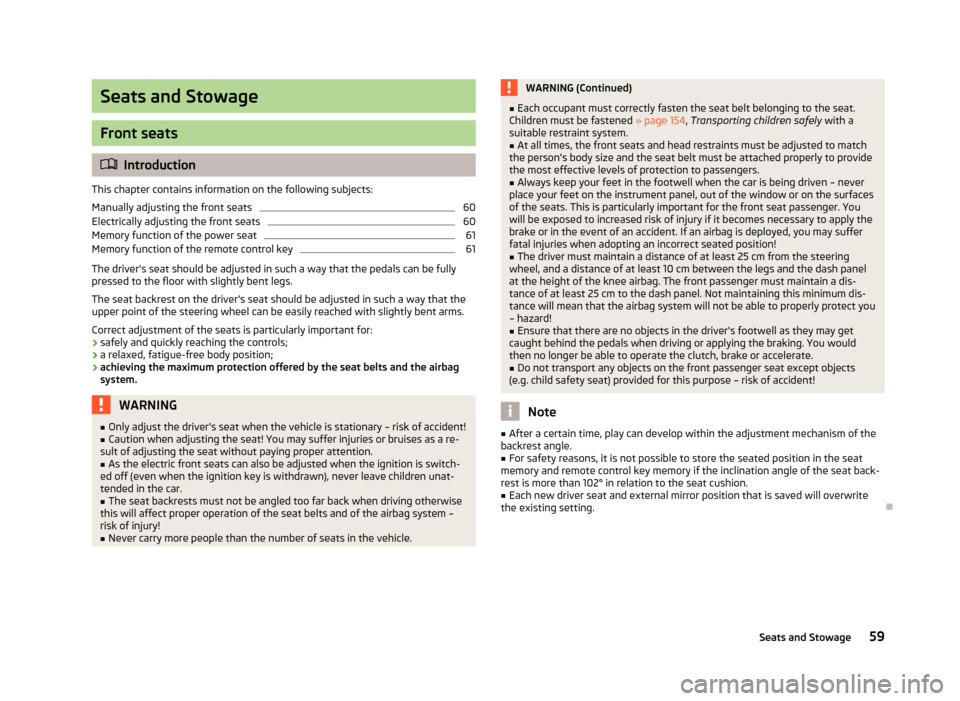
Seats and Stowage
Front seats
ï¤Introduction
This chapter contains information on the following subjects:
Manually adjusting the front seats
60
Electrically adjusting the front seats
60
Memory function of the power seat
61
Memory function of the remote control key
61
The driver's seat should be adjusted in such a way that the pedals can be fully
pressed to the floor with slightly bent legs.
The seat backrest on the driver's seat should be adjusted in such a way that the
upper point of the steering wheel can be easily reached with slightly bent arms.
Correct adjustment of the seats is particularly important for:
⺠safely and quickly reaching the controls;
⺠a relaxed, fatigue-free body position;
⺠achieving the maximum protection offered by the seat belts and the airbag
system.
WARNINGâ Only adjust the driver's seat when the vehicle is stationary â risk of accident!â Caution when adjusting the seat! You may suffer injuries or bruises as a re-
sult of adjusting the seat without paying proper attention.â
As the electric front seats can also be adjusted when the ignition is switch-
ed off (even when the ignition key is withdrawn), never leave children unat-
tended in the car.
â
The seat backrests must not be angled too far back when driving otherwise
this will affect proper operation of the seat belts and of the airbag system â
risk of injury!
â
Never carry more people than the number of seats in the vehicle.
WARNING (Continued)â Each occupant must correctly fasten the seat belt belonging to the seat.
Children must be fastened » page 154, Transporting children safely with a
suitable restraint system.â
At all times, the front seats and head restraints must be adjusted to match
the person's body size and the seat belt must be attached properly to provide
the most effective levels of protection to passengers.
â
Always keep your feet in the footwell when the car is being driven â never
place your feet on the instrument panel, out of the window or on the surfaces
of the seats. This is particularly important for the front seat passenger. You
will be exposed to increased risk of injury if it becomes necessary to apply the
brake or in the event of an accident. If an airbag is deployed, you may suffer
fatal injuries when adopting an incorrect seated position!
â
The driver must maintain a distance of at least 25 cm from the steering
wheel, and a distance of at least 10 cm between the legs and the dash panel at the height of the knee airbag. The front passenger must maintain a dis-
tance of at least 25 cm to the dash panel. Not maintaining this minimum dis-
tance will mean that the airbag system will not be able to properly protect you
â hazard!
â
Ensure that there are no objects in the driver's footwell as they may get
caught behind the pedals when driving or applying the braking. You would
then no longer be able to operate the clutch, brake or accelerate.
â
Do not transport any objects on the front passenger seat except objects
(e.g. child safety seat) provided for this purpose â risk of accident!
Note
â After a certain time, play can develop within the adjustment mechanism of the
backrest angle.â
For safety reasons, it is not possible to store the seated position in the seat
memory and remote control key memory if the inclination angle of the seat back-
rest is more than 102° in relation to the seat cushion.
â
Each new driver seat and external mirror position that is saved will overwrite
the existing setting.
ï
59Seats and Stowage
Page 63 of 222
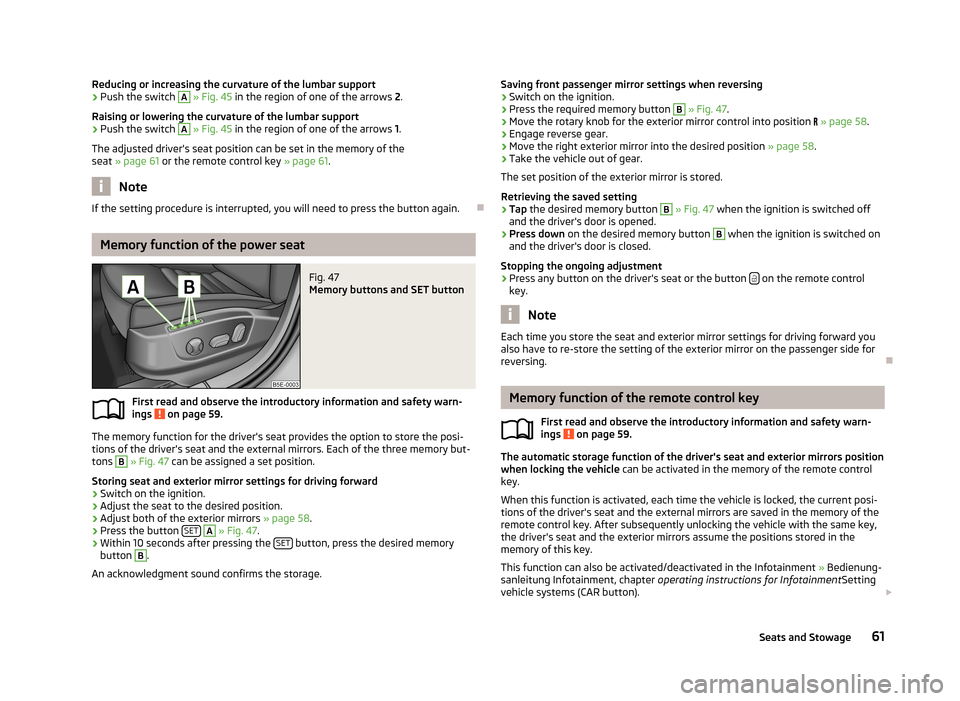
Reducing or increasing the curvature of the lumbar supportâºPush the switch A » Fig. 45 in the region of one of the arrows 2.
Raising or lowering the curvature of the lumbar supportâº
Push the switch
A
» Fig. 45 in the region of one of the arrows 1.
The adjusted driver's seat position can be set in the memory of the
seat » page 61 or the remote control key » page 61.
Note
If the setting procedure is interrupted, you will need to press the button again.ï
Memory function of the power seat
Fig. 47
Memory buttons and SET button
First read and observe the introductory information and safety warn-
ings on page 59.
The memory function for the driver's seat provides the option to store the posi- tions of the driver's seat and the external mirrors. Each of the three memory but-
tons
B
» Fig. 47 can be assigned a set position.
Storing seat and exterior mirror settings for driving forward
âº
Switch on the ignition.
âº
Adjust the seat to the desired position.
âº
Adjust both of the exterior mirrors » page 58.
âº
Press the button SET
A
» Fig. 47 .
âº
Within 10 seconds after pressing the SET button, press the desired memory
button
B
.
An acknowledgment sound confirms the storage.
ï¤Saving front passenger mirror settings when reversingâºSwitch on the ignition.âº
Press the required memory button
B
» Fig. 47 .
âº
Move the rotary knob for the exterior mirror control into position ï » page 58 .
âº
Engage reverse gear.
âº
Move the right exterior mirror into the desired position » page 58.
âº
Take the vehicle out of gear.
The set position of the exterior mirror is stored.
Retrieving the saved setting
âº
Tap the desired memory button
B
» Fig. 47 when the ignition is switched off
and the driver's door is opened.
âº
Press down on the desired memory button
B
when the ignition is switched on
and the driver's door is closed.
Stopping the ongoing adjustment
âº
Press any button on the driver's seat or the button ï¦ on the remote control
key.
Note
Each time you store the seat and exterior mirror settings for driving forward you
also have to re-store the setting of the exterior mirror on the passenger side for
reversing.ï
Memory function of the remote control key
First read and observe the introductory information and safety warn-ings
on page 59.
The automatic storage function of the driver's seat and exterior mirrors position
when locking the vehicle can be activated in the memory of the remote control
key.
When this function is activated, each time the vehicle is locked, the current posi-
tions of the driver's seat and the external mirrors are saved in the memory of the remote control key. After subsequently unlocking the vehicle with the same key,the driver's seat and the exterior mirrors assume the positions stored in the
memory of this key.
This function can also be activated/deactivated in the Infotainment » Bedienung-
sanleitung Infotainment, chapter operating instructions for Infotainment Setting
vehicle systems (CAR button). ï£
ï¤61Seats and Stowage
Page 64 of 222

Activating the functionâºUnlock the vehicle with the remote control key.âº
Press and hold any memory button
B
» Fig. 47 on page 61. After the seat has
assumed the position stored under this button, at the same time press the but-
ton ï¦
on the remote control key within 10 seconds.
The successful activation of the function is confirmed by an audible signal. The seat and exterior mirror settings are not saved in the memory of the key,
which is already saved in the memory button.
The seat can be adjusted to the required position if necessary » page 60.
After locking the vehicle, the current positions of the driver's seat and the exter-
nal mirrors are saved in the memory of the remote control key.
Deactivating the function
âº
Unlock the vehicle with the remote control key.
âº
Press and hold the SET button
A
» Fig. 47 on page 61. At the same time, press
the button ï¦ on the remote control key within 10 seconds.
The successful deactivation of the function is confirmed by an audible signal.
Stopping the ongoing adjustment
âº
Press any button on the driver's seat or the button ï¦ on the remote control
key.
ï
Seat heaters
Fig. 48
Heating: Front seats/ rear seats
The seat backrests and surfaces of the front seats and the two outer rear seats can be heated electrically.
The seat heating can only be switched on when the engine is running.
Switching onâº
Press the button ï¡ or ï
» Fig. 48 .
By pressing the button once, the heating is switched to the highest intensity - level 3, which is indicated by three of the warning lights underneath theswitch » Fig. 48 - ï or in the button » Fig. 48 - ï lighting up.
With repeated pressing of the switch, the level of the seat heating is down-regu- lated up to the switch-off. The level of the seat heating is indicated by the num-
ber of illuminated warning lights underneath/in the switch.
WARNINGIf, as an occupant, you have a subdued pain and/or temperature sensitivity,
e.g. through medication, paralysis or because of chronic illness (e.g. diabetes),
we recommend not to use the seat heating. This can lead to burns on the
back, the posterior and the legs which are difficult to heal. If the seat heating
is used, we recommend to make regular breaks in your journey when driving
long distances, so that the body can recuperate from the stress of the jour- ney. Please consult your doctor, who can evaluate your specific condition.
CAUTION
â Do not kneel on the seats or otherwise apply concentrated pressure to them.â Do not use the seat heaters if the seats are not occupied by persons or if ob-
jects, such as a child seat, bag, etc., are fastened or stored on them. A fault of the
heating elements in the seat heating can occur.â
Do not clean the seats using moisture » page 164, Fabric covers on electrically
heated seats .
Note
â
If the on-board voltage drops, the seat heating is switched off automatically, in
order to provide sufficient electrical energy for the engine control » page 180,
Automatic load deactivation .â
If the heaters for the rear seats are set to the highest intensity - level 3, they
are automatically switched over to level 2 after 10 minutes.
ï
62Using the system
Page 104 of 222
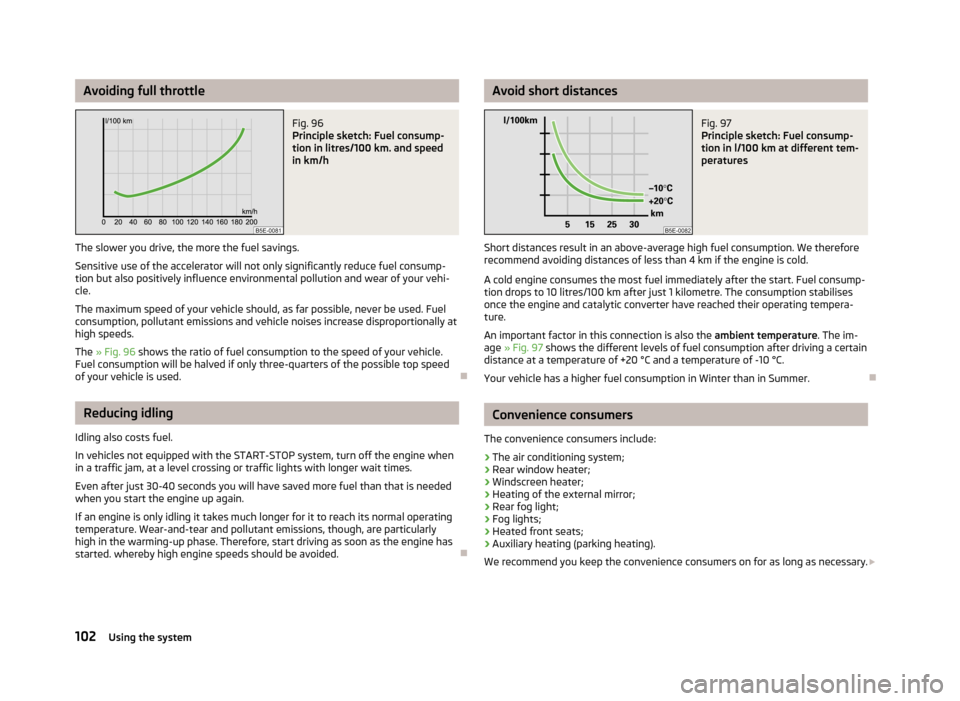
Avoiding full throttleFig. 96
Principle sketch: Fuel consump-
tion in litres/100 km. and speed
in km/h
The slower you drive, the more the fuel savings.
Sensitive use of the accelerator will not only significantly reduce fuel consump- tion but also positively influence environmental pollution and wear of your vehi-
cle.
The maximum speed of your vehicle should, as far possible, never be used. Fuel
consumption, pollutant emissions and vehicle noises increase disproportionally at
high speeds.
The » Fig. 96 shows the ratio of fuel consumption to the speed of your vehicle.
Fuel consumption will be halved if only three-quarters of the possible top speed
of your vehicle is used.
ï
Reducing idling
Idling also costs fuel.
In vehicles not equipped with the START-STOP system, turn off the engine when
in a traffic jam, at a level crossing or traffic lights with longer wait times.
Even after just 30-40 seconds you will have saved more fuel than that is needed
when you start the engine up again.
If an engine is only idling it takes much longer for it to reach its normal operating
temperature. Wear-and-tear and pollutant emissions, though, are particularly
high in the warming-up phase. Therefore, start driving as soon as the engine has
started. whereby high engine speeds should be avoided.
ï
Avoid short distancesFig. 97
Principle sketch: Fuel consump-
tion in l/100 km at different tem-
peratures
Short distances result in an above-average high fuel consumption. We therefore recommend avoiding distances of less than 4 km if the engine is cold.
A cold engine consumes the most fuel immediately after the start. Fuel consump- tion drops to 10 litres/100 km after just 1 kilometre. The consumption stabilises once the engine and catalytic converter have reached their operating tempera-
ture.
An important factor in this connection is also the ambient temperature. The im-
age » Fig. 97 shows the different levels of fuel consumption after driving a certain
distance at a temperature of +20 °C and a temperature of -10 °C.
Your vehicle has a higher fuel consumption in Winter than in Summer.
ï
Convenience consumers
The convenience consumers include:
⺠The air conditioning system;
⺠Rear window heater;
⺠Windscreen heater;
⺠Heating of the external mirror;
⺠Rear fog light;
⺠Fog lights;
⺠Heated front seats;
⺠Auxiliary heating (parking heating).
We recommend you keep the convenience consumers on for as long as necessary. ï£
102Using the system
Page 112 of 222
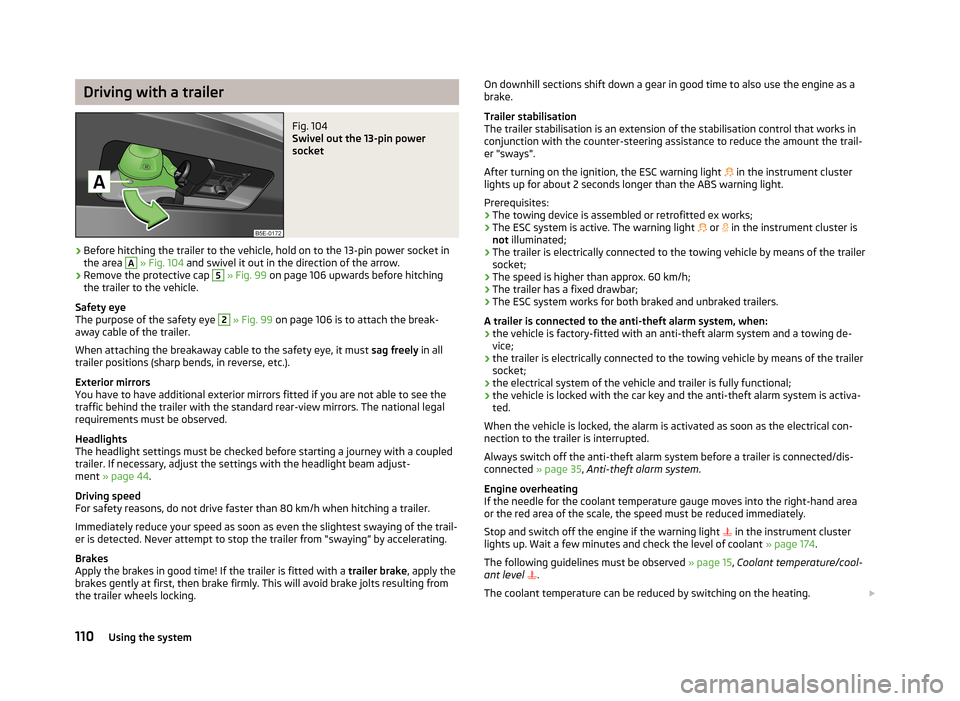
Driving with a trailerFig. 104
Swivel out the 13-pin power
socket
âº
Before hitching the trailer to the vehicle, hold on to the 13-pin power socket in the area
A
» Fig. 104 and swivel it out in the direction of the arrow.
âº
Remove the protective cap
5
» Fig. 99 on page 106 upwards before hitching
the trailer to the vehicle.
Safety eye
The purpose of the safety eye
2
» Fig. 99 on page 106 is to attach the break-
away cable of the trailer.
When attaching the breakaway cable to the safety eye, it must sag freely in all
trailer positions (sharp bends, in reverse, etc.).
Exterior mirrors
You have to have additional exterior mirrors fitted if you are not able to see the
traffic behind the trailer with the standard rear-view mirrors. The national legal
requirements must be observed.
Headlights
The headlight settings must be checked before starting a journey with a coupled
trailer. If necessary, adjust the settings with the headlight beam adjust-
ment » page 44 .
Driving speed
For safety reasons, do not drive faster than 80 km/h when hitching a trailer.
Immediately reduce your speed as soon as even the slightest swaying of the trail- er is detected. Never attempt to stop the trailer from âswayingâ by accelerating.
Brakes
Apply the brakes in good time! If the trailer is fitted with a trailer brake, apply the
brakes gently at first, then brake firmly. This will avoid brake jolts resulting from
the trailer wheels locking.
On downhill sections shift down a gear in good time to also use the engine as a
brake.
Trailer stabilisation
The trailer stabilisation is an extension of the stabilisation control that works in
conjunction with the counter-steering assistance to reduce the amount the trail-
er "sways".
After turning on the ignition, the ESC warning light ï¢ in the instrument cluster
lights up for about 2 seconds longer than the ABS warning light.
Prerequisites: ⺠The towing device is assembled or retrofitted ex works;
⺠The ESC system is active. The warning light
ï¢ or ï« in the instrument cluster is
not illuminated;
⺠The trailer is electrically connected to the towing vehicle by means of the trailer
socket;
⺠The speed is higher than approx. 60 km/h;
⺠The trailer has a fixed drawbar;
⺠The ESC system works for both braked and unbraked trailers.
A trailer is connected to the anti-theft alarm system, when: ⺠the vehicle is factory-fitted with an anti-theft alarm system and a towing de-
vice;
⺠the trailer is electrically connected to the towing vehicle by means of the trailer
socket;
⺠the electrical system of the vehicle and trailer is fully functional;
⺠the vehicle is locked with the car key and the anti-theft alarm system is activa-
ted.
When the vehicle is locked, the alarm is activated as soon as the electrical con-
nection to the trailer is interrupted.
Always switch off the anti-theft alarm system before a trailer is connected/dis- connected » page 35, Anti-theft alarm system .
Engine overheating
If the needle for the coolant temperature gauge moves into the right-hand area or the red area of the scale, the speed must be reduced immediately.
Stop and switch off the engine if the warning light ï¯
in the instrument cluster
lights up. Wait a few minutes and check the level of coolant » page 174.
The following guidelines must be observed » page 15, Coolant temperature/cool-
ant level ï¯
.
The coolant temperature can be reduced by switching on the heating. ï£110Using the system
Page 140 of 222
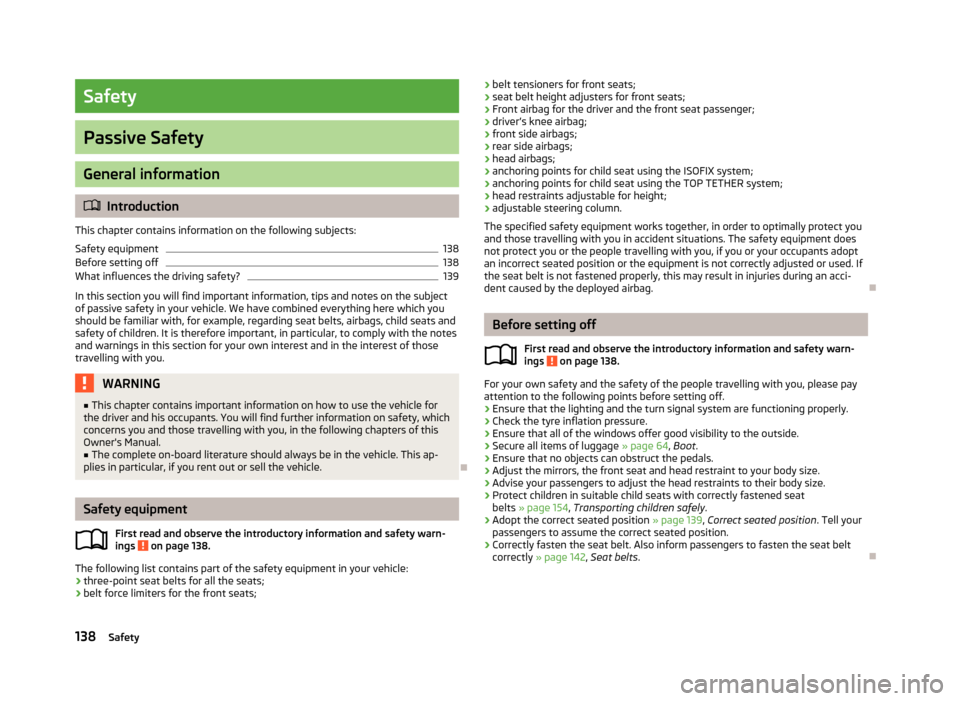
Safety
Passive Safety
General information
ï¤Introduction
This chapter contains information on the following subjects:
Safety equipment
138
Before setting off
138
What influences the driving safety?
139
In this section you will find important information, tips and notes on the subject
of passive safety in your vehicle. We have combined everything here which you
should be familiar with, for example, regarding seat belts, airbags, child seats and safety of children. It is therefore important, in particular, to comply with the notes
and warnings in this section for your own interest and in the interest of those
travelling with you.
WARNINGâ This chapter contains important information on how to use the vehicle for
the driver and his occupants. You will find further information on safety, which concerns you and those travelling with you, in the following chapters of this
Owner's Manual.â
The complete on-board literature should always be in the vehicle. This ap-
plies in particular, if you rent out or sell the vehicle.
ï
Safety equipment
First read and observe the introductory information and safety warn-ings
on page 138.
The following list contains part of the safety equipment in your vehicle:
⺠three-point seat belts for all the seats;
⺠belt force limiters for the front seats;
ï¤âº
belt tensioners for front seats;
⺠seat belt height adjusters for front seats;
⺠Front airbag for the driver and the front seat passenger;
⺠driverâs knee airbag;
⺠front side airbags;
⺠rear side airbags;
⺠head airbags;
⺠anchoring points for child seat using the ISOFIX system;
⺠anchoring points for child seat using the TOP TETHER system;
⺠head restraints adjustable for height;
⺠adjustable steering column.
The specified safety equipment works together, in order to optimally protect you
and those travelling with you in accident situations. The safety equipment does
not protect you or the people travelling with you, if you or your occupants adopt
an incorrect seated position or the equipment is not correctly adjusted or used. If
the seat belt is not fastened properly, this may result in injuries during an acci-
dent caused by the deployed airbag.
ï
Before setting off
First read and observe the introductory information and safety warn-
ings
on page 138.
For your own safety and the safety of the people travelling with you, please pay
attention to the following points before setting off.
⺠Ensure that the lighting and the turn signal system are functioning properly.
⺠Check the tyre inflation pressure.
⺠Ensure that all of the windows offer good visibility to the outside.
⺠Secure all items of luggage
» page 64, Boot .
⺠Ensure that no objects can obstruct the pedals.
⺠Adjust the mirrors, the front seat and head restraint to your body size.
⺠Advise your passengers to adjust the head restraints to their body size.
⺠Protect children in suitable child seats with correctly fastened seat
belts » page 154 , Transporting children safely .
⺠Adopt the correct seated position
» page 139, Correct seated position . Tell your
passengers to assume the correct seated position.
⺠Correctly fasten the seat belt. Also inform passengers to fasten the seat belt
correctly » page 142 , Seat belts .
ï
ï¤138Safety